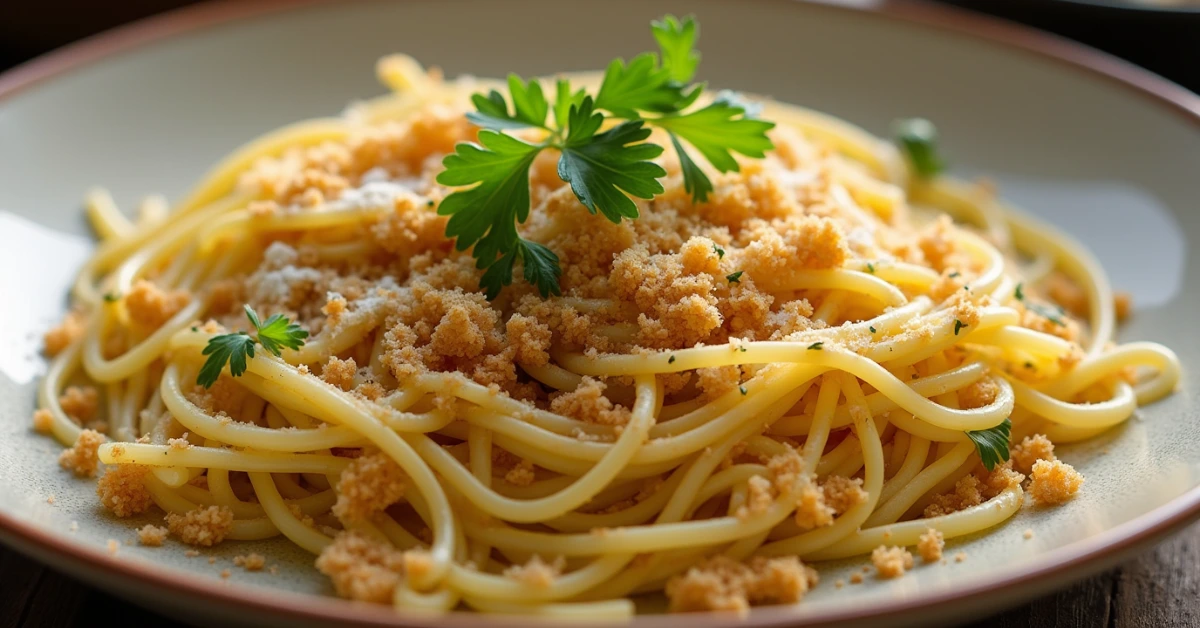Making bread and crumbs at home is easier than you think and the results are so much better than store-bought. Have you ever found yourself with stale bread and wondered what to do with it? Turning it into crispy, flavorful breadcrumbs is the perfect solution. Homemade breadcrumbs give you control over texture and flavor, whether you prefer them fine for coating or coarse for a crunchy topping.
With just a few simple ingredients like stale bread, olive oil, and sea salt, you can create delicious breadcrumbs that elevate everything from pasta to salads. The best part? You’ll avoid waste while creating a versatile kitchen staple. Whether you’re looking to add a crispy topping to a casserole or a flavorful coating for cutlets, this easy recipe has you covered.
If you’ve ever struggled with soggy or bland breadcrumbs, this guide will show you how to fix that for good. Let’s dive into the steps to make the perfect batch of crispy bread and crumbs at home.
Table of Contents
1. Why You’ll Love This Recipe
Making bread and crumbs at home is more than just a way to use up stale bread it’s a game-changer in the kitchen. Here’s why this recipe will become a staple in your cooking routine:
- Better Texture and Flavor – Store-bought breadcrumbs can be bland and overly fine. Homemade breadcrumbs let you control the texture, giving you the option of a coarse, crispy finish or a finer crumb for coating and binding.
- Simple and Versatile – You only need a few basic ingredients like stale bread, olive oil, and sea salt to make delicious breadcrumbs. You can adjust the seasoning to match your dish from Italian herbs to garlic powder.
- Avoid Food Waste – Got leftover stale bread or crusty ends? Instead of tossing them, turn them into a handy kitchen staple. Homemade breadcrumbs are perfect for sprinkling over pasta, adding crunch to salads, or coating chicken cutlets.
- Healthier Option – Making breadcrumbs at home lets you skip the preservatives and additives in store-bought versions. Plus, you can adjust the salt and oil to suit your taste and dietary needs.
If you’ve struggled with soggy or flavorless breadcrumbs in the past, this recipe will change that. The result? Perfectly crispy, golden breadcrumbs that elevate any dish from baked casseroles to crispy cutlets.
2.Ingredients for Homemade Bread and Crumbs
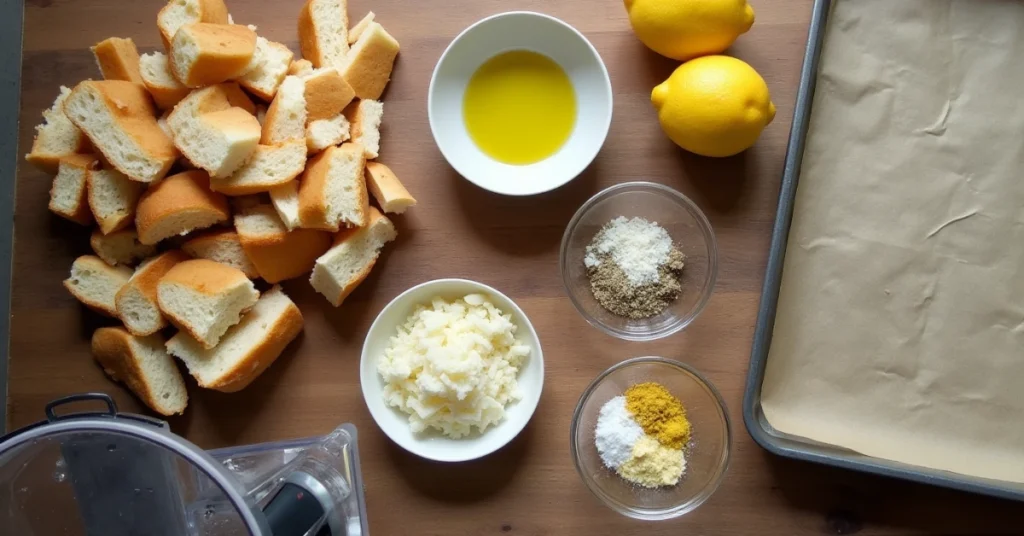
You don’t need much to make crispy, flavorful bread and crumbs at home. Here’s what you’ll need:
For the Breadcrumbs:
- 4 ounces stale sourdough bread – Torn into small pieces (about 2–3 cups). You can also use other types of stale bread like baguette or sandwich bread for a different texture and flavor.
- 2 tablespoons extra-virgin olive oil – Helps the crumbs crisp up in the oven and adds a rich, savory flavor.
- ¼ teaspoon sea salt – Enhances the flavor of the breadcrumbs.
For Seasoned Breadcrumbs (Optional):
- ¼ cup grated pecorino cheese (or vegan Parmesan) – Adds a salty, umami flavor.
- ½ teaspoon lemon zest – Brightens the flavor of the breadcrumbs.
- ½ teaspoon garlic powder – Adds depth and a subtle garlic kick.
- ½ teaspoon Italian seasoning – A mix of herbs like oregano and basil to give the crumbs a classic Italian touch.
Optional Add-ins:
- Onion powder – Adds a mild, savory sweetness.
- Red pepper flakes – For a little heat.
- Fresh herbs – Like parsley or thyme for a fresh, earthy flavor.
Why These Ingredients Work:
- Stale bread creates the best texture because it’s already dry, which helps it crisp up evenly.
- Olive oil ensures the breadcrumbs bake to a golden brown without burning.
- Seasonings allow you to customize the flavor to match your dish whether it’s a pasta topping, a salad crunch, or a coating for cutlets.
Feel free to mix and match seasonings based on your taste and the dish you’re preparing. The key is to keep the texture crispy and the flavor balanced.
3. Instructions to Make Breadcrumbs
Follow these simple steps to make crispy, flavorful bread and crumbs at home. The process is quick and easy, and you’ll end up with perfect homemade breadcrumbs every time.
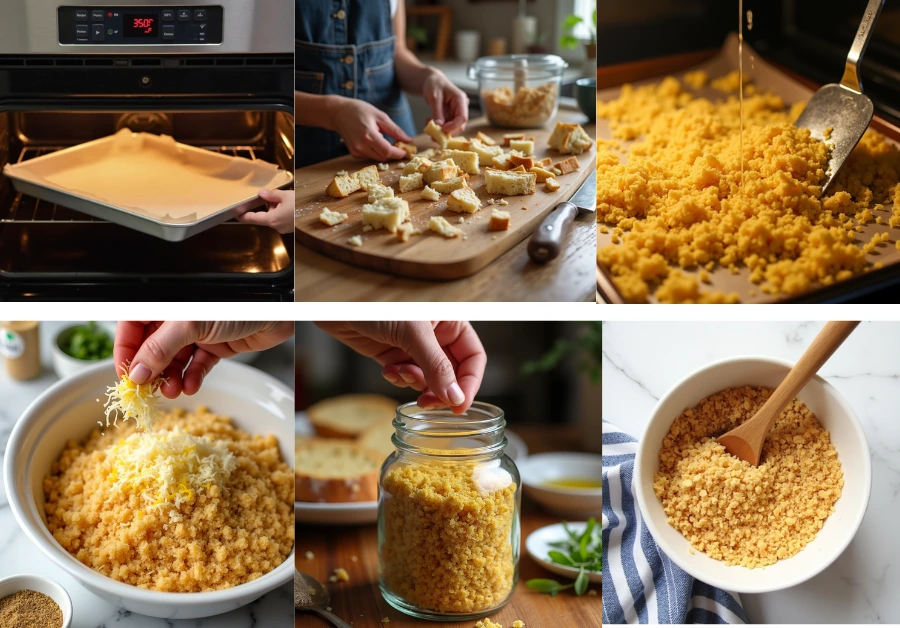
1. Preheat the Oven
- Set your oven to 350°F (175°C).
- Line a baking sheet with parchment paper to prevent sticking and ensure even crisping.
2. Prepare the Bread
- Tear the stale bread into small, even pieces (about 1-inch pieces). Removing the crust is optional keeping it adds more texture and a deeper flavor.
- Transfer the bread pieces to a food processor.
- Pulse the bread until you reach your desired texture:
- For fine breadcrumbs – Pulse longer until the pieces are small and uniform.
- For coarse breadcrumbs – Pulse less to keep some larger pieces for added crunch.
3. Bake Until Crispy
- Spread the crumbs in an even layer on the lined baking sheet.
- Drizzle with olive oil and sprinkle with sea salt. Toss gently to coat evenly.
- Bake for 10 to 18 minutes, tossing halfway through to ensure even browning. The crumbs should be golden brown and crispy.
4. Season and Cool
- Once baked, transfer the crumbs to a bowl.
- Mix in the pecorino cheese, lemon zest, and any other seasonings you prefer (like garlic powder or Italian seasoning).
- Let the breadcrumbs cool completely before storing to prevent moisture buildup.
5. Store for Later
- Keep the breadcrumbs in a sealed container at room temperature, and they will stay fresh for up to three months.
- For longer storage, freeze them in a sealed bag they’ll stay fresh for up to 6 months.
Pro Tip:
If the breadcrumbs lose their crispiness over time, pop them in the oven at 350°F for a few minutes to revive the texture.
This method ensures that your bread and crumbs turn out crispy, flavorful, and versatile perfect for topping pasta, coating chicken, or adding crunch to salads.
4. Pro Tips and Variations for Better Breadcrumbs
Making perfect bread and crumbs is simple, but a few smart adjustments can elevate the flavor and texture even more. Here’s how to customize and perfect your homemade breadcrumbs:
1. Adjust the Texture
- For fine breadcrumbs – Pulse longer in the food processor until the crumbs are small and uniform. Fine crumbs work well as a binder in meatballs or as a coating for cutlets.
- For coarse breadcrumbs – Pulse less to keep some larger pieces intact. Coarse crumbs create a crunchy topping for pasta or casseroles.
2. Maximize Crispiness
- Use stale bread – Fresh bread holds too much moisture, which prevents crisping. If your bread is too fresh, bake it at 250°F for 5–10 minutes to dry it out before pulsing.
- Don’t overcrowd the baking sheet – Spread the crumbs in an even layer so they bake evenly and crisp up properly.
3. Customize the Flavor
- Italian Style – Add garlic powder, onion powder, and Italian seasoning for a savory touch.
- Spicy Kick – Mix in a pinch of red pepper flakes or cayenne pepper for heat.
- Cheesy Twist – Stir in more pecorino or try Parmesan for a salty, umami flavor.
- Herb Blend – Fresh herbs like parsley or thyme add a bright, earthy note.
4. Storage Tips
- Let the breadcrumbs cool completely before storing to avoid moisture buildup.
- Store in an airtight container at room temperature for up to 3 months.
- Freeze extra breadcrumbs in a sealed bag they’ll stay fresh for up to 6 months.
5. Quick Fix for Soggy Breadcrumbs
- If your breadcrumbs soften over time, bake them at 350°F for a few minutes to bring back the crunch.
6. Use Different Types of Bread
- Sourdough – Adds a tangy depth of flavor.
- Baguette – Creates light, crispy crumbs.
- Whole Wheat – Gives a heartier, nutty flavor.
- Sandwich Bread – Soft texture that works well for finer breadcrumbs.
- Marble Rye – For a rich, slightly sweet flavor, try using Marble Rye Bread for unique and flavorful breadcrumbs.
Experiment with different types of bread and seasonings to find the flavor and texture that works best for you. These tips ensure your homemade bread and crumbs are always crispy, flavorful, and ready to elevate any dish.
5. Serving Suggestions for Bread and Crumbs
Homemade bread and crumbs are incredibly versatile, adding texture and flavor to a wide range of dishes. Here are some of the best ways to use them:
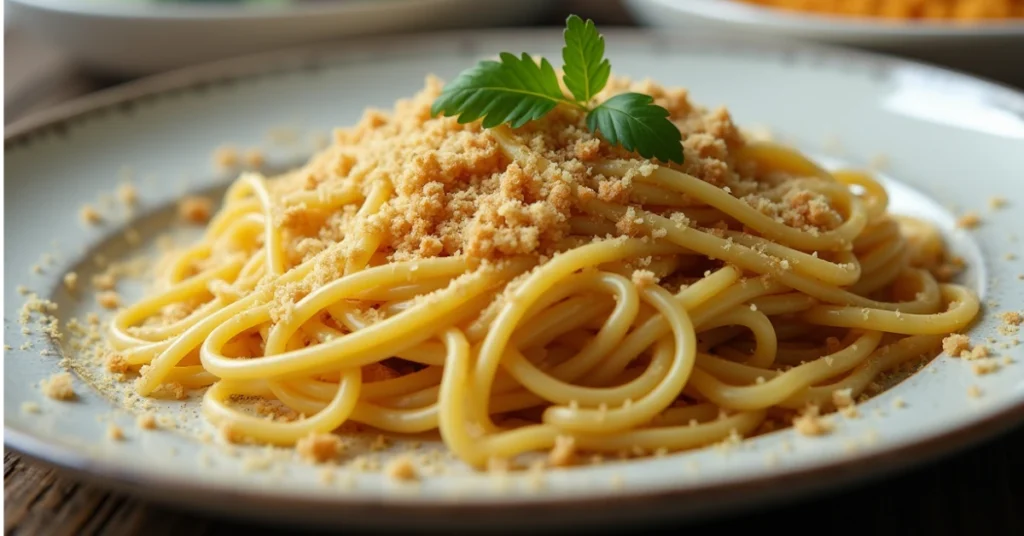
1. Pasta Topping
- Sprinkle toasted breadcrumbs over pasta with olive oil, garlic, and red pepper flakes for a quick, flavorful meal.
- Try it with spaghetti aglio e olio or creamy Alfredo for extra texture and crunch.
2. Salad Crunch
- Use coarse breadcrumbs as a topping for leafy greens or grain-based salads.
- Toss with a little olive oil and lemon zest to add a bright, crunchy element.
3. Coating for Cutlets
- Use breadcrumbs to coat chicken, fish, or eggplant before frying or baking.
- For extra crispiness, mix in some grated pecorino or Parmesan.
4. Casserole Topping
- Spread seasoned breadcrumbs over casseroles and bake until golden brown.
- Works perfectly with mac and cheese, baked ziti, or vegetable bakes.
5. Stuffing and Meatballs
- Mix breadcrumbs into stuffing or meatballs to improve texture and help bind the mixture together.
- Season with garlic powder and Italian seasoning for more flavor.
6. Soup Garnish
- Sprinkle breadcrumbs over creamy soups like tomato or butternut squash for a crunchy contrast.
- Toast them with olive oil and garlic for extra flavor.
7. Vegetable Coating
- Toss vegetables like zucchini or eggplant in seasoned breadcrumbs before roasting or air frying.
- Adds a crispy, golden finish to any vegetable side dish.
Quick Tip:
For the best texture, always add breadcrumbs as a topping just before serving to keep them crispy.
Whether you’re using them as a pasta topping, salad crunch, or coating for cutlets, homemade bread and crumbs bring flavor and texture to any meal. Experiment with different seasonings and bread types to match your dish and taste preferences.
6. Conclusion
Making your own bread and crumbs at home is simple, rewarding, and a great way to reduce food waste. With just a few basic ingredients and a little time, you can create crispy, flavorful breadcrumbs that elevate everything from pasta to salads.
Homemade breadcrumbs give you control over texture and flavor. Whether you prefer fine crumbs for coating cutlets or coarse crumbs for a crunchy casserole topping, this recipe allows you to customize the result to match your dish. Plus, using stale bread means you’re making the most of what you already have in the kitchen.
The best part? You can adjust the seasoning, experiment with different types of bread, and store them for months. They’re perfect to have on hand for quick, easy meal upgrades.
Give this recipe a try you’ll be amazed at how much better homemade bread and crumbs taste compared to store-bought.
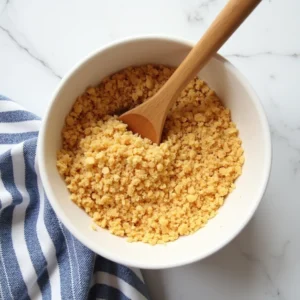
Crispy Bread and Crumbs Recipe
Ingredients
For the Breadcrumbs:
- 4 ounces stale sourdough bread about 2–3 cups, torn into small pieces
- 2 tablespoons extra-virgin olive oil
- ¼ teaspoon sea salt
For Seasoned Breadcrumbs (Optional):
- ¼ cup grated pecorino cheese or vegan Parmesan
- ½ teaspoon lemon zest
- ½ teaspoon garlic powder
- ½ teaspoon Italian seasoning
Optional Add-ins:
- ¼ teaspoon onion powder
- ¼ teaspoon red pepper flakes
- 1 tablespoon fresh herbs like parsley or thyme
Instructions
Preheat the Oven
- Set your oven to 350°F (175°C).
- Line a baking sheet with parchment paper to prevent sticking and ensure even crisping.
Prepare the Bread
- Tear the stale bread into small, even pieces (about 1-inch pieces). Removing the crust is optional — keeping it adds more texture and a deeper flavor.
- Transfer the bread pieces to a food processor.
- Pulse the bread until you reach your desired texture:
- For fine breadcrumbs – Pulse longer until the pieces are small and uniform.
- For coarse breadcrumbs – Pulse less to keep some larger pieces for added crunch.
Bake Until Crispy
- Spread the crumbs in an even layer on the lined baking sheet.
- Drizzle with olive oil and sprinkle with sea salt. Toss gently to coat evenly.
- Bake for 10 to 18 minutes, tossing halfway through to ensure even browning. The crumbs should be golden brown and crispy.
Season and Cool
- Once baked, transfer the crumbs to a bowl.
- Mix in the pecorino cheese, lemon zest, and any other seasonings you prefer (like garlic powder or Italian seasoning).
- Let the breadcrumbs cool completely before storing to prevent moisture buildup.
Store for Later
- Keep the breadcrumbs in a sealed container at room temperature, and they will stay fresh for up to three months.
- For longer storage, freeze them in a sealed bag they’ll stay fresh for up to 6 months.
Notes
- Calories: 120 kcal
- Total Fat: 5g
- Saturated Fat: 1g
- Cholesterol: 5mg
- Sodium: 210mg
- Total Carbohydrates: 15g
- Dietary Fiber: 1g
- Sugar: 1g
- Protein: 4g
7. FAQs About Bread and Crumbs
Can I make breadcrumbs without a food processor?
Yes! If you don’t have a food processor, you can tear the stale bread into small pieces and use a rolling pin or a grater to break them down. For finer crumbs, place the bread in a sealed plastic bag and crush it with a rolling pin until you reach the desired texture.
How do I keep my breadcrumbs crispy?
To maintain the crispiness of breadcrumbs, keep them in a tightly sealed container at room temperature. If they soften over time, bake them at 350°F for a few minutes to restore the crunch.
What’s the best type of bread to use for homemade breadcrumbs?
Stale sourdough works best for a tangy flavor and crispy texture. You can also use baguette for light crumbs, whole wheat for a nutty taste, or sandwich bread for soft, fine crumbs.
How long can I store homemade breadcrumbs?
Store breadcrumbs in an airtight container at room temperature for up to 3 months. For longer storage, freeze them in a sealed bag for up to 6 months.
Can I season breadcrumbs after baking?
Yes! It’s best to season breadcrumbs after baking to prevent burning. Mix in garlic powder, Italian seasoning, lemon zest, or grated pecorino once the breadcrumbs have cooled.
Can I use fresh bread to make breadcrumbs?
It’s better to use stale bread since fresh bread holds too much moisture. If you only have fresh bread, bake it at 250°F for 5–10 minutes to dry it out before processing.
What’s the difference between fine and coarse breadcrumbs?
Fine breadcrumbs – Best for coating cutlets or binding meatballs.
Coarse breadcrumbs – Ideal for pasta toppings, salad crunch, and casserole layers.
Can I make gluten-free breadcrumbs?
Yes! Use gluten-free bread and follow the same process. The texture and crispiness will vary slightly depending on the type of gluten-free bread you use.
Why are my breadcrumbs burning in the oven?
If the breadcrumbs are burning, the oven may be too hot. Keep the temperature at 350°F and toss the breadcrumbs halfway through baking to prevent over-browning.
Can I add cheese to my breadcrumbs?
Yes! Adding pecorino or Parmesan enhances the flavor. Just be sure to mix in the cheese after baking to prevent it from burning.

